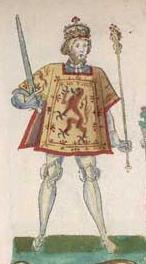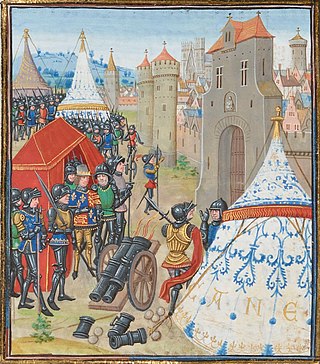
Edward of Woodstock, known to history as the Black Prince, was the eldest son and heir apparent of King Edward III of England. He died before his father and so his son, Richard II, succeeded to the throne instead. Edward nevertheless earned distinction as one of the most successful English commanders during the Hundred Years' War, being regarded by his English contemporaries as a model of chivalry and one of the greatest knights of his age.
Sir Thomas Duffus Hardy was an English archivist and antiquary, who served as Deputy Keeper of the Public Record Office from 1861 to 1878.
Thomas Rymer was an English poet, critic, antiquary and historian. His lasting contribution was to compile and publish 16 volumes of the first edition of Foedera, a work in 20 volumes conveying agreements between The Crown of England and foreign powers since 1101. He held the office of English Historiographer Royal from 1692 to 1714. He is credited with coining the phrase "poetic justice" in The Tragedies of the Last Age Consider'd (1678).

Walter Hungerford, 1st Baron Hungerford was an English knight and landowner, from 1400 to 1414 a Member of the House of Commons, of which he became Speaker, then was an Admiral and peer.

John of Eltham, 1st Earl of Cornwall was the second son of Edward II of England and Isabella of France. He was heir presumptive to the English throne until the birth of his nephew Edward, the Black Prince.

Sir Edmund Verney was an English politician, soldier and favourite of King Charles I. At the outbreak of the English Civil War he supported the Royalist cause and was killed at the Battle of Edgehill.

Sir William Walworth was an English nobleman and politician who was twice Lord Mayor of London. He is best known for killing Wat Tyler during the Peasants' Revolt in 1381.
John Philipot was an officer of arms at the College of Arms in London and a politician who sat in the House of Commons from 1628 to 1629. Though he successfully attained the position on Somerset Herald of Arms in Ordinary, he is best known for his production of a roll of arms of the Lord Wardens of the Cinque Ports.
Sir Nicholas Brembre was a wealthy magnate and a chief ally of King Richard II in 14th-century England. He was Lord Mayor of London in 1377, and again from 1384–5,6. Named a "worthie and puissant man of the city" by Richard Grafton, he became a citizen and grocer of London, and in 1372-3 purchased from the Malmains family the estates of Mereworth, Maplescomb, and West Peckham, in Kent. His ties to Richard ultimately resulted in his downfall, as the anti-Richard Lords Appellant effectively took control of the government and imprisoned, exiled, or executed most of Richard's court. Despite Richard's efforts, Brembre was executed in 1388 for treason at the behest of the Lords Appellant.
In July 1482 an English army invaded Scotland during the Anglo-Scottish Wars. The town of Berwick-upon-Tweed and its castle were captured and the English army briefly occupied Edinburgh. These events followed the signing of the Treaty of Fotheringhay, 11 June 1482, in which Alexander Stewart, Duke of Albany, the brother of James III of Scotland declared himself King of Scotland and swore loyalty to Edward IV of England. The follow-up invasion of Scotland under the command of Edward's brother, Richard, Duke of Gloucester failed to install Albany on the throne, but Berwick has remained English ever since the castle surrendered on 24 August. The English army left Edinburgh with a promise for the repayment of the dowry paid for the marriage of Princess Cecily of England to the Scottish Prince.

Sir John Tregonwell was a Cornish jurist, a principal agent of Henry VIII and Thomas Cromwell in the Dissolution of the Monasteries. He served as Judge of the High Court of Admiralty from 1524 to 1536.
Sir William Herrick or Hericke was an English jeweller, courtier, diplomat and politician who sat in the House of Commons at various times between 1601 and 1622.

The Treaty of York (1464) was made between England and Scotland on 1 June 1464 at York and was intended to establish 15 years of peace. Previously Scotland had supported the defeated House of Lancaster in the English civil War of the Roses.
John Sotherton the younger (1562–1631) was an English judge, member of a prominent parliamentary, judicial and mercantile family of London and East Anglia, who became Cursitor Baron of the Exchequer in 1610.

The Reims campaign took place during the Hundred Years' War. It occurred after the French de facto government rejected the terms of the Treaty of London and consequently Edward III of England organised and commanded an expeditionary army to gain by force what he had failed to win by diplomacy. On 28 October 1359 Edward landed at Calais, and advanced to Reims, where he hoped to be crowned king of France. The strenuous resistance of the citizens frustrated this scheme, and Edward marched into Burgundy, and then he made his way back towards Paris. Failing in an attack on the capital, he was glad to conclude, on 8 May 1360, preliminaries of peace at Brétigny, near Chartres. This treaty, less onerous to France than that of London, took its final form when Edward and John ratified the treaty in Calais on 9 October 1360. By it Edward renounced his claim to France in return for Aquitaine and other French territories in full sovereignty.

Sir Robert de Ogle was an English soldier and feudal landowner in Northumbria who fought in the border conflicts with Scotland. He captured five Scottish knights near Newcastle in 1341 and was licensed to crenellate Ogle House. He distinguished himself in resisting the foray into Cumberland of Sir William Douglas in 1345, fought at Neville's Cross in 1346 and took three nobles prisoner, and held Berwick Castle against the Scots in 1355.
Simon Binham or Bynham was an English chronicler and Benedictine monk of the priory of Binham, Norfolk. He assisted the prior of Binham in opposing the exactions of Hugh, abbot of St. Albans, and was imprisoned for some time with the other rebellious monks. He is said to have contributed to the continuation of the Chronicle of Rishanger, but his other writings are largely lost.
Thomas Philipot was an English poet and miscellaneous writer. The son of Somerset herald John Philipot, he proceeded M.A. at Clare Hall, Cambridge, regiis literis, in 1636, and was incorporated in that degree at Oxford in 1640. He published some poetical works and contributed to miscellanies.
Sir Henry Spigurnel was an English judge. He was summoned to parliaments of Edward I and Edward II, and was made a justice of oyer and terminer in 1300. He was sent on a mission to papal court in 1311 and interpreted the ordinances in 1312. He retired in 1327, and died the next year.













